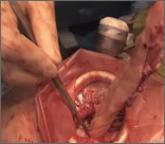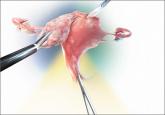Surgical Techniques

Tissue extraction at minimally invasive surgery: Where do we go from here?
Open power morcellation now is contraindicated in perimenopausal and postmenopausal women. What is Johns Hopkins’ protocol in this new climate? An...
expert commentary
Robert L. Barbieri, MD
Kate Macy Ladd Professor of Obstetrics, Gynecology, and Reproductive Biology, Harvard Medical School and Chair, Obstetrics and Gynecology, Brigham and Women’s Hospital, Boston, Massachusetts. Dr. Barbieri is the Editor in Chief of OBG Management.
Dr. Barbieri reports no financial relationships relevant to this article.

Stratified by age, a patient’s risk of an occult uterine cancer at myomectomy is 1 in 2,337 if she is younger than 40 years, 1 in 702 if she is 40 to 49 years, 1 in 154 if she is 50 to 59 years, and 1 in 31 if she is 60 years or older, according to this retrospective database analysis of more than 41,000 women.
Wright and colleagues analyzed the risk of diagnosing an occult uterine cancer at the time of myomectomy using an administrative database, which contained information on 41,777 myomectomy surgeries performed at 496 hospitals from 2006 to 2012. They reported that 76 uterine corpus cancers (ICD-9 codes 179.x and 182.x) were detected, for a rate of 1 occult cancer identified per 550 myomectomy cases. The risk of diagnosing an occult uterine cancer increased with age.
Study limitations
A major weakness of the study is that the administrative database did not provide information about the histologic type of uterine corpus cancer. Uterine leiomyosarcoma is a highly aggressive cancer, while endometrial stromal sarcoma is a more indolent cancer. Additionally, the authors were not able to perform a histologic reassessment of the slides of the 76 cases reported as having uterine corpus cancer in order to confirm the diagnosis. Although the investigators provide age-specific information about the risk of uterine cancer, they did not have information on the menopausal status of the women.
Strengths of the study
Prior to these study results there were few data about the risk of diagnosing an occult cancer at the time of myomectomy. This very large study of more than 41,000 myomectomy cases will help clinicians fully counsel women about the risk of detecting an occult uterine cancer at the time of myomectomy.
What this evidence means for practice
Women aged 50 years or older should be advised against having a myomectomy given the 1 in 154 and 1 in 31 risk of identifying an occult uterine corpus cancer at the time of surgery in women aged 50 to 59 years and 60 years or older, respectively. Given an average age of menopause of 51 years, these data support the guidance of the US Food and Drug Administration that open electric power morcellation should not be used in surgery on uterine tumors in women who are perimenopausal or postmenopausal.
–Robert L. Barbieri, MD
Share your thoughts! Send your Letter to the Editor to rbarbieri@frontlinemedcom.com. Please include your name and the city and state in which you practice.

Open power morcellation now is contraindicated in perimenopausal and postmenopausal women. What is Johns Hopkins’ protocol in this new climate? An...

Dr. William Parker discusses the FDA's estimate of the incidence of occult uterine malignancy at the time of benign hysterectomy and explains why...


In this roundtable discussion, five surgical experts weigh in on the state of minimally invasive gynecology and current age-based options for...
